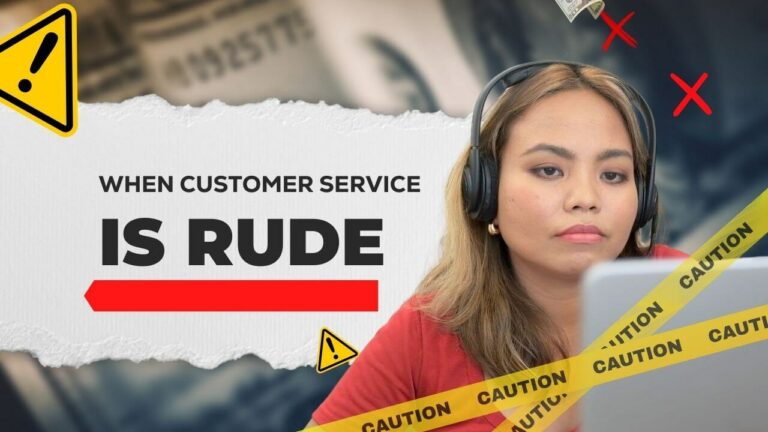There is no one-size-fits-all guide to expressing empathy. And that’s because it depends on your customers’ situations. Some customers are simply more upset than others, some are stuck in horrible, dead-end situations, while others still have feasible solutions to their problems. The way you deal with all of these is similar but not exactly identical.
So, in this article, I’ve put together 6 mock calls representing 6 different scenarios with explanations. These should guide you to appropriately empathize depending on the situation. Here’s how to show empathy in customer service for call center agents.
Table of Contents
1. Start with the default empathy statements.
Scenario 1: The customer casually mentions an unfortunate event in passing but is not emotional.
Agent: Did you register your account or did you sign up as a guest?
Customer: I signed up as a guest. I didn’t have the time for it. My employer passed away and I had to stay in the hospital for a few days so I haven’t had the time to create my account.
Agent: I’m so sorry to hear that. My condolences.
Customer: Thank you.
Agent: Would you like me to create an account for you or do you prefer to log in as a guest?
Customer: Yes, please. That would be a great idea. That would make things easier for me.
In my opinion, it’s better to start with the default and generic I’m so sorry to hear that. My condolences. if the customer isn’t particularly emotional or isn’t revealing extensive information about the unfortunate event.
If she merely mentions it in passing, chances are, she does not intend to talk extensively about it with a stranger.
However, if she reveals more information that you’re not asking about, it’s a sure sign for you to lend a listening ear and personalize your empathy statements.
In this example, however, the customer only said thank you to the agent’s offer of condolences. She didn’t volunteer more information; there is no indication of her being upset. Therefore, proceeding to the subject at hand is recommended. After all, you have an AHT (average handling time) to maintain.
This is not about intentionally neglecting the customer so you can shorten your AHT. This is about gauging her feelings and reacting according to what’s socially acceptable.
In this case, since she doesn’t show any sign of being upset and wanting to talk extensively about the death, then it’s socially acceptable to proceed to the reason for her call.
2. If the customer is upset, listen then personalize your empathy statements.
Scenario 2: The customer is emotionally affected and is showing it.
Agent: Have you registered your account or did you sign up as a guest?
Customer: I signed up as a guest. I didn’t have the time for it. My employer passed away and I had to stay in the hospital for a few days so I haven’t had the time to create my account.
Agent: I’m so sorry to hear that. My condolences.
Customer: Thank you. It was such an ordeal for him. 83 years old, he was. He got cancer, no kids, no relatives. I was the only one with him the entire time.
Agent: I can only imagine how tough that must be.
Customer: Oh, you have no idea. There’s something about it that’s just beyond sad, you know. To see someone dying without a family to take care of him. I’m telling you, I wouldn’t wish that on my worst enemies.
Agent: Oh, I get you, I get you. I think anyone can relate, really. To be honest, I’m not looking forward to getting old myself. And cancer is such a horrible, horrible disease! I hope you’re taking care of yourself right now.
Customer: Thank you. You’re so kind. I’ll be seeing my family this weekend so that should help a lot.
Agent: You do that. That’s a really good idea. We all need people in our lives.
Customer: I definitely will. Thank you!
Agent: And if you want, I can create the account for you so you don’t have to fill out the form. Would you prefer that?
Customer: Oh, that would be wonderful. Thank you, honey. It’s just been so hard this week.
Agent: Of course, of course. No problem at all! I’m here to help.
In this call, the customer is undoubtedly upset and is showing it. As opposed to the previous customer who only said Thank you, she volunteered more information that the agent did not ask about.
Instead of stopping at thank you, she revealed how greatly her employer had suffered, that he had no kids, and how terribly saddened she was. This is an unmistakable sign that she wanted a listening ear.
Imagine if the agent had gotten directly to the point without acknowledging her outburst, it would no doubt come off as insensitive. And for good reason. We all want to be heard and if someone is as upset as this, it’s only a natural to empathize.
Agent: Oh, I get you, I get you. I think anyone can relate. To be honest, I’m not looking forward to getting old myself. And cancer is such a horrible, horrible disease! I hope you’re taking care of yourself right now.
Here, the agent personalized her empathy statement by first listening to the customer, putting herself in her shoes, then revealing a reaction that is personal to her. This is a good way to empathize because it’s genuine.
But notice that before the agent was able to come up with that personalized empathy statement, she first let the customer vent. She didn’t say anything unique. By initially saying I can only imagine how tough that must be, she gave the customer the floor to vent. Remember, the most crucial part of showing empathy is through listening.
There’s a misconception that we have to say something unique for our empathy to sound genuine. But that’s only possible after listening.
Worry not about what to say at first; the default statements will initially save you. As soon as you listen and let the customer talk, you’ll eventually discover information that’ll help you come up with a genuine empathetic response.
3. If the customer is happy and excited, match his/her enthusiasm.
Customer: So I was browsing your store this morning. I’m shopping for baby dresses. You know, we just found out that we’re having a baby girl.
Agent: Oh, congratulations! That’s fantastic!
Customer: Thank you! We did buy some gender-neutral colors but now that we’re sure it’s a baby girl, I thought pink! I need lots of pinks!
Agent: Hmm, you are just in time. We have an entire catalog launched just this morning for baby girls with pink palettes. Want me to send you the link?
Agent: Yes, please. Send it to me. I’m dying to see it!
Empathizing when a customer is happy is quite simple: simply match the customer’s level of excitement by smiling. A smile is always audible over the phone and adds warmth to any voice.
Of course, if the customer, like the previous example, discloses additional information that you’re not asking about that simply sounding excited isn’t enough, try to tell stories in your life that relate to your customer’s.
In this example, tell stories about happy pregnancies. It could be of people you know or your own.
- That’s wonderful! I can still remember when I was pregnant with my daughter. I was so excited! I could barely contain myself. I know exactly what you’re feeling right now. Congratulations!
- That’s wonderful! I can still remember when my wife was finally pregnant with our daughter, I was so excited...
4. If the customer is wrong and verbally abusive, stand your ground and issue a warning.
Customer: I’m so sick of your company. All the incompetence, the mishaps, the inconveniences that you’ve been causing me since I’ve been a member.
Agent: This is frustrating for you. I understand. Initially, we give a onetime exception for missed bills. And this we gave you last March 2018. Because this is a second occurrence, we will be imposing the penalty.
Customer: No, no, no. Don’t bullsh*t me with I understand. Of course, you don’t understand! How could you? You’re white, I’m an immigrant, you just work there, you’re paid to read off a script, and then you leave and you forget about everything.
How could you possibly understand a poor woman like me? Are you in my situation, huh? Are you a single mother? Are you jobless? Well, guess what, you’re none of those things! I bet you have a man taking care of you. I’m alone! How can you possibly not understand how unfair your company is treating me right now? Because you don’t understand me! You’re not in my situation so don’t pretend to understand.
Agent: Emma, we understand that mistakes happen. Deadlines could be missed. Bills can be left unpaid for some time. That’s why we gave you a onetime exception. But since this is a second occurrence, and this is something I’ve consulted with the management just now, we believe it is fair to charge a penalty this time. This is the final decision of the management.
Customer: So, you’re not going to help me. Is that what you’re saying?
Agent: This time, we cannot because you have reached the limit of our exception as per our policy.
Customer: I want to talk to your manager.
Agent: I am the manager. Sophie transferred you to me.
Customer: No, no, no. I want someone higher up! I’m done talking to you. I don’t care about you. You’re an uncaring b*tch!
Agent: I’m going to have to warm you from using profanities. I am the highest contact you can talk to in this office. But I can give you the email of our CEO.
Customer: He doesn’t take phone calls? Your CEO doesn’t take phone calls!
Agent: He doesn’t take phone calls but he communicates to customers via email.
Customer: F*ck you, f*ck you, f*ck you! You’re a c*nt! I couldn’t care less about your fucking CEO, I will get you fired for this. I will make sure that they fire you for this!
Agent: Emma, due to profanities, I can no longer continue this conversation. I have explained our position and the decision is final. If you have more questions in the future, feel free to call us back. Thank you for calling Kwestyon. Bye!
If a customer is hostile, verbally abusive, and wrong, your best strategy is to sound firm but polite. Acknowledge the hardship caused by your refusal but always reiterate the logic behind your decision. Some will accept it with barely a grumble while some with reactions ranging from mild annoyance to all-out hysteria.
Always stand your ground with wrong and hysterical customers. If they personally attack you, do not bite on the bait; do not respond to emotional manipulations. Call them out for the profanities but never engage emotionally.
For example, taking it personally would be responding like this, “Ma’am, you don’t know anything about my life. I have my own problems but I’m not acting like a victim.”
Don’t do it! This will only fuel their desire for an argument and prolong the time you have to talk to them.
In fact, it’s quite useful to assume an unemotional yet professional voice. A firm voice will send the message that they’re not having the effect they hope they’d have on you, which, in turn will force them to disengage sooner.
Think of them as toddlers having tantrums. If you engage, you lose both your time and sanity. So, don’t.
5. If the customer is wrong but not cursing, still stand your ground.
Customer: I’m so sick of your company. All the incompetence, the mishaps, the inconveniences that you’ve been causing me since I’ve been a member.
Agent: This is frustrating for you. I understand. Normally, we give a onetime exception for missed bills. And this we gave you last March 2018. Because this is a second occurrence, we will have to impose the penalty.
Customer: Yeah, you already told me that. It’s just not fair. I just feel like you ought to do something more for your longtime customers than just a onetime exception. You can do better than that! That’s ridiculously an insubstantial favor for years and years of me paying my bills on time. Don’t you think that I deserve better than just a onetime exception? Like maybe one exception every 3 years that I’m with you? That’d be reasonable, don’t you think?
Agent: I see your point. You’ve been with us for 10 years now. And this is something I also brought up with the management today when I put you on hold. As it turns out, it was agreed that the decision is final and that the penalty will be charged this time.
Customer: Oh, okay. So in other words, you don’t care about your customers. Okay, got it.
Agent: We do recognize that mistakes happen. Deadlines are missed. Bills can be left unpaid for some time. That’s why we gave you a onetime exception. But for the second occurrence, we would have to charge a penalty.
Customer: All right. Whatever. I’m done with this.
Agent: Is there anything else that I can help you with today?
Customer: You haven’t helped me at all but thanks for nothing.
Agent: I wish I could have been of help. Thank you for calling Kwestyon. Have a great day.
Here, the customer is rude but not verbally abusive. You cannot end a call just because a customer is rude.
Instead, you should repeatedly paraphrase the same message until it hits home. Irate customers will try to poke holes in your statements but if you repeat it enough times in a professional tone, they eventually give up.
In this example, the agent responded, I see your point to the customer’s demand for another exception due to her being a longtime customer. This is a good way to show that she’s not simply being dismissed and that some of her points are being acknowledged.
At the very least, the representative was able to prevent the customer from cursing or asking for a supervisor for the same answer.
In short, when you’re stuck in calls where there is nothing to do but uphold the company policy, acknowledge the sane/semi-sane points made by your customers as well as their feelings, but ultimately end your statements with a firm nod to the policy. After all, what other choice is there?
6. If the company is wrong, apologize, admit the mistake, but highlight the resolution.
In this call, the customer was livid because she received a cutting board instead of the oven she ordered. This is unquestionably the company’s fault.
The job, therefore, is to first pacify the customer. You can do this by apologizing and owning up to the mistake, plain and simple. Second, and if you can, offer an explanation of why it happened so customers could get some clarity. Third, highlight the resolution.
Depending on how upset the customer is, you might have to paraphrase a few times until she cools down and be open enough to listen to reason.
But essentially, you should diffuse the anger first, then offer the resolution second. Without addressing their emotions, they will not listen to reason.
More examples:
- I sincerely apologize for this disruption. This is definitely not what we want you to experience. Let me fix this for you. I will now call a technician to come over to your residence within 24 hours.
- I’m sorry that you had to deal with this. Normally, prior to packaging, the shipping team checks and ensures that each order is accurate. There has been an error in your case. And I can only imagine how worried you are right now with the wedding date approaching fast. Here’s what I can do for you…
If you have any questions or would like to request more customer service scenarios with mock calls, visit my YouTube channel Kwestyon then and leave a comment on one of my videos. Good luck!






